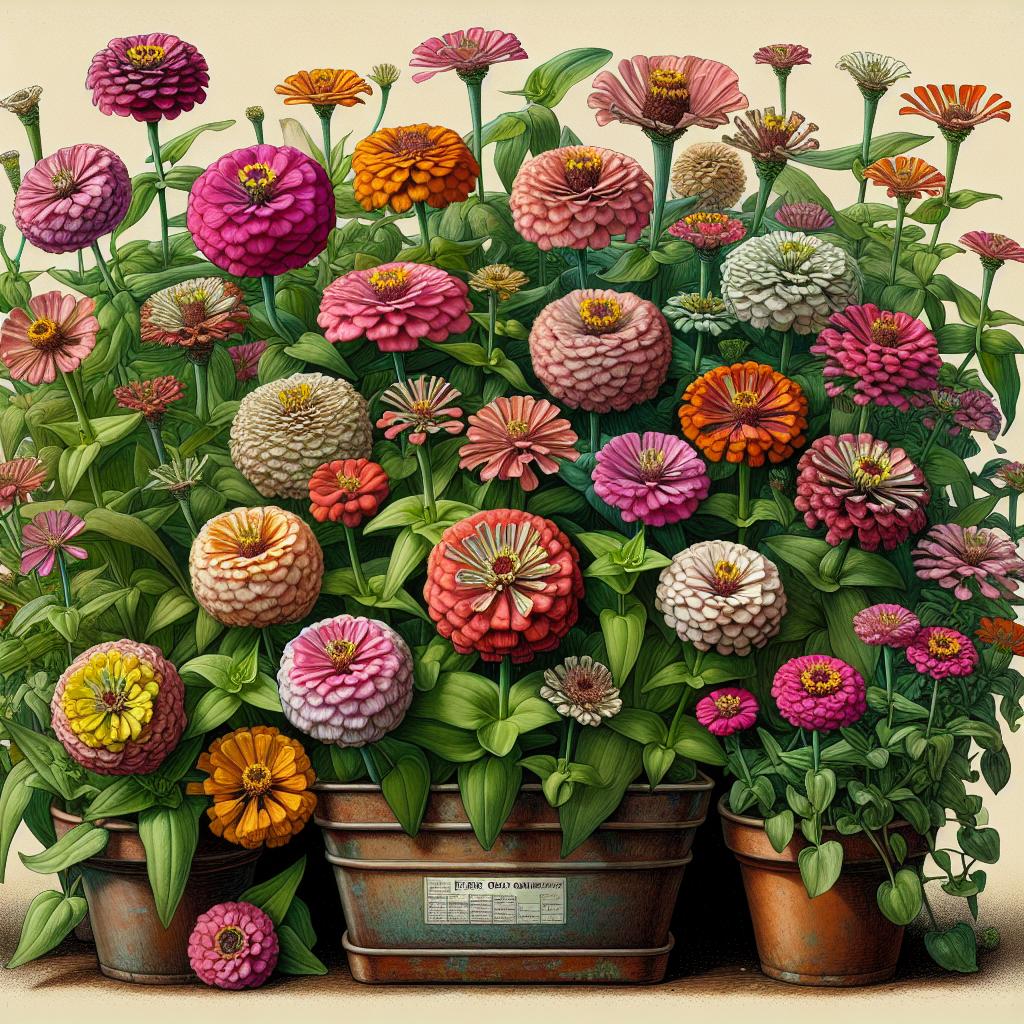Zinnia Plants for Edge Gardens and Raised Beds

1. Choosing the right Zinnia varieties for edge gardens
Title: Choosing the Right Zinnia Varieties for Edge Gardens: A Comprehensive Guide
Introduction
Zinnias, often known as the Star of the Garden, are a highly popular choice among active gardeners and green-thumbed enthusiasts worldwide. Their dynamism, captivating charm, and the myriad of colors they exhibit make them a perfect choice for edging gardens. These flowers not only enhance the beauty of the overall landscape but also act as a vibrant border drawing attention to the garden’s main features. This article will guide you through choosing the right Zinnia varieties for edge gardens.
Edging Zinnia Plant Types – Overview
Zinnias come in a wide range of heights, sizes, forms, and colors. They are classified into three primary categories based on their heights: Dwarf Zinnias, Medium Height Zinnias, and Tall Zinnias. When selecting Zinnias for edge gardens, it’s best to stick with dwarf and medium height varieties as they offer a perfect complement to your garden without obscuring the view of other plants.
Dwarf Zinnias For Edging
Dwarf Zinnias, standing at a height between 6 to 10 inches, go well with most borders. These miniature beauties work great in tiny spaces, pathways, and corners due to their compact growth. Some perfect examples are:
‘Thumbelina’ – An award-winning dwarf variety, boasting a radiant variety of double, semi-double and single daisy-like flowers stretching up to an inch across.
‘Zahara’ Series – Renowned for their resistance to disease, especially powdery mildew and leaf spot, the Zahara series comes in a delightful palette of warm colors.
Medium Height Zinnias For Edging
Medium Height Zinnias are typically 15 to 30 inches tall and are an excellent choice for edging larger gardens. They offer a bit more privacy and interest, without dominating the garden.
“The zinnia was probably the outstanding one of the total group. It’s a big plant with very nice flowers that didn’t seem to be affected by diseases.”
~ Dave Wildung
Look out for these varieties:
‘Swizzle’ Series – These bicolor beauties stand out with their unusual color combinations. ‘Cherry and Ivory’ and ‘Scarlet and Yellow’ are especially popular.
‘Dreamland’ Series – Offering a display of large semi-double flowers up to 4 inches across, Dreamland Zinnias appear in an array of vibrant colors and have a robust, compact growth.
Choosing the Right Color Palette
Zinnias come in nearly every shade except for blue, providing an excellent opportunity to experiment with color coordination. Warmer hues like red, gold, and orange can add a touch of flamboyance whereas pastel shades like lavender, light pink and white lend a serene, peaceful quality to the garden.
Shaping Your Edges
Weaving a tapestry of colors and heights with Zinnias, you can customize your garden edge. Think of a rising sun model with the smallest ones in front gradually stepping up to a bit taller counterparts, or a border with alternating colors for a fun, whimsical rhythm in your garden.
Care for Your Edging Zinnias
Regardless of the variety, Zinnias need full sun, warm temperatures, and well-drained soil. Regular watering, careful pruning, and occasional fertilizing will boost their bloom and keep them healthy.
Conclusion
Zinnias, with their exuberant colors and varieties, are a wonderful addition to any edge garden. Choosing the right Zinnias can significantly uplift your garden’s aura and accentuate its beauty. With their easy-care nature and sustained bloom, enhancing your garden with a vibrant edge has never been easier! So wait no more, get started with your selection of Zinnias for a bountiful and vibrant edge garden.
Enjoyed This? Here’s More: 1. Choosing The Right Zinnia Varieties For Edge Gardens

2. Care and maintenance of Zinnia in raised beds
Title: The Optimal Care and Maintenance of Zinnias in Raised Beds
Cultivating zinnias in raised beds can be a rewarding endeavor for gardening enthusiasts. With their dazzling array of colors and variety in height and bloom size, zinnias add a dash of elegance and vibrancy to any garden. The legalization of zinnias can be relatively straightforward, given the appropriate knowledge and care. Below we share insightful information on how to maintain and care for zinnias in raised beds for a garden that never stops blooming.
First, let’s delve into the advantages of growing Zinnias in raised beds. Raised beds improve the overall soil condition; they are warmer, have better drainage, reduces soil compaction, and present fewer difficulties with weeds. This gardening approach not only contributes towards better growth of zinnias but also makes the maintenance more manageable.
Care for zinnias begins with their planting and continues through their growth process. Zinnias, native to Mexico, are sun-loving plants, so choose a location for your beds where they will get at least 6 hours of sunlight a day. Preparing the raised bed is an essential step in the process. Loosen up the soil with a garden fork, ensuring it’s light and has efficient drainage. Zinnias prefer a well-drained soil with a neutral to slightly acidic pH.
When it comes to sowing zinnia seeds, space them to about 4 to 24 inches apart, depending upon the variety. The drier the seeds remain, the better their chances of avoiding fungal diseases. Water them gently using a watering can that diffuses the flow, so it doesn’t wash the seeds away or create divots.
One critical aspect of raising zinnias is their susceptibility to powdery mildew.
“Health economists have estimated that an injection of 50 million per year in Indigenous clinical care, and 0 million in preventative care, is required to provide services at the same level as for any other group with the health conditions of Indigenous Australians.”
~ Malcolm Fraser
This fungal disease manifests itself as a white powdery substance on the zinnias’ leaves and stems. Good airflow, both within and between the plants, can prevent this. Hence, be cautious not to overcrowd your plants and, when watering, try to keep the foliage as dry as possible to prevent the spore’s growth.
Regular deadheading is another crucial maintenance aspect for Zinnias. This process involves removing dead or dying flowers, encouraging new growth and prolonging the blooming period. Deadheading also keeps the plants looking tidy and vibrant.
Zinnias, being low feeders, do not require regular fertilization. However, a little compost or a slow-release granular fertilizer at the beginning of the growing season can help them grow vigorously. Avoid over-fertilization as it may lead to more foliar growth at the expense of flowers.
Lastly, though zinnias are relatively pest-free, they can fall prey to aphids and spider mites. Regular inspections of your plants can allow early detection and treatment. A strong water spray can dislodge aphids while insecticidal soap sprayed early in the morning can treat spider mites.
With their vast color palette and tolerance for different climatic conditions, zinnias are a charming addition to any garden. Taking the time to plant them in raised beds, ensuring they receive the right care and maintenance, can result in a summer-long color display in your garden. With patience, love, and understanding of their needs, you can successfully nurture zinnias in raised garden beds.
Source: 2. Care And Maintenance Of Zinnia In Raised Beds

3. Maximizing Zinnia bloom in edge gardens and raised beds
Title: Unleashing Beauty: 3 Strategies to Maximize Zinnia Bloom in Edge Gardens and Raised Beds
When it comes to adding vibrancy and life to your garden, few plants can match the exuberant personality of the zinnia. Zinnias are a gardener’s delight, offering a lush palette of colors that can brighten up any space. They’re brilliantly suited for edge gardens or raised beds, where they can fully display their flamboyant blooms. However, to maximize the bloom of zinnias, a certain level of care is required.
This article will guide you through three strategies to spur your zinnias into an enchanting bloom in your edge gardens and raised beds.
1. Optimal Planting Conditions
The first step towards coaxing the best possible bloom from your zinnias lies in establishing the optimal planting conditions. Zinnias are sun-loving plants, commonly associated with long, hot summers. Be sure to plant your zinnias in places with ample sun exposure.
In an edge garden or raised bed, this often means planting them at the outer edges to avoid being overshadowed by larger plants. Zinnias prefer well-drained, loamy or sandy soil, enriched with compost or organic matter. Mind that the soil pH lies between 5.5 and 7.5. With these conditions met, you’re setting your zinnias up for a stellar growth season.
2. Proactive Pest and Disease Management
Part of the zinnias’ magnetic charm comes from their susceptibility to attract butterflies. But they can also, unfortunately, attract less desirable visitors, such as aphids and spider mites.
“The zinnia was probably the outstanding one of the total group. It’s a big plant with very nice flowers that didn’t seem to be affected by diseases.”
~ Dave Wildung
Therefore, proactive pest management is essential to protecting your vibrant blooms.
Regularly inspect your zinnias for visible signs of pests, like discolored leaves or the pests themselves. Organic pesticides such as neem oil or insecticidal soaps can help combat these intruders without harming the surrounding environment. Additionally, zinnias can be prone to fungal diseases such as powdery mildew and leaf spot. Improving air circulation around the plants and watering at the base rather than overhead can help prevent these issues.
3. Encourage Continuous Blooming
The last secret to maximizing your zinnia bloom lies in the art of deadheading. This process involves removing faded or dead flowers to encourage the plant to produce more blooms instead of seeds. Left unchecked, a zinnia will divert its energy towards seed production, leading to fewer and fewer blooms as the season progresses.
As the peak of the flowering season arrives, make a habit of strolling through your garden with shears in hand, snipping off spent blooms. This little bit of horticultural housekeeping can encourage a profusion of color right up until the first frost.
The spectacle of a blooming zinnia garden or raised bed is truly a sight to behold, a grand display of nature’s capacity for radiant beauty. But more than that, it’s a testament to the harmonious dance between gardener and plant, where a little attention and care can help nature achieve its fullest potential. Embrace these three strategies, and watch your zinnias burst into a cascading flood of vibrant color, a glorious spectacle for the senses. Enjoy!
Like This? Try: 3. Maximizing Zinnia Bloom In Edge Gardens And Raised Beds






